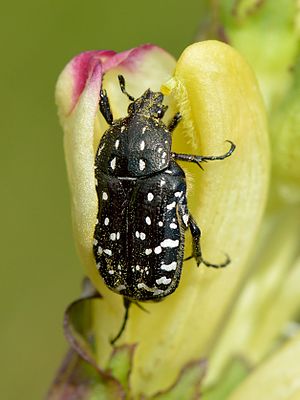Mourning rose beetle
| Mourning rose beetle | ||||||||||||
|---|---|---|---|---|---|---|---|---|---|---|---|---|

Mourning rose chafer ( Oxythyrea funesta ) |
||||||||||||
| Systematics | ||||||||||||
|
||||||||||||
| Scientific name | ||||||||||||
| Oxythyrea funesta | ||||||||||||
| ( Poda , 1761) |
The mourning rose beetle ( Oxythyrea funesta ) is a beetle from the subfamily of the rose beetles (Cetoniinae).
features
The beetles are 8 to 12 millimeters long. Their body is glossy black and has, in addition to a shaggy, white hair, many small white spots on the wings , the pronotum and the underside of the body. The six spots on the pronotum run in two parallel longitudinal rows on both sides of the middle of the pronotum, on which a longitudinal callus is formed. The upper wings have five raised longitudinal stripes. In older specimens, there are usually no hairs to be found, as these will rub off over time.
Occurrence
The animals live in warm areas, especially in North Africa and the rest of the Mediterranean , east to Transcaucasia on steppe heaths and limestone soils. The species is also found near forest edges and flower-rich meadows . They are also very rarely found in southwest Germany. They fly from May to July.
Way of life
The adults feed on pollen, the larvae on plant roots. The females lay a few eggs one at a time in the ground. The larvae are up to 30 millimeters long. The adult beetles hatch before autumn, but they can also remain in the ground until the next spring.
Hazard and protection
In some federal states, such as Bavaria , the mourning rose beetle has become rare and endangered. Protective measures mentioned are the promotion and expansion of near-natural, extensive forms of grazing, the maintenance and protection of grasslands, inland dunes, moors and flowing waters with natural dynamics, and increasing the proportion of old and dead wood in near-natural forest areas.
- Red list Germany: 2 (endangered)
- Red List Bavaria: 1 (threatened with extinction)
supporting documents
Individual evidence
- ↑ Federal Agency for Nature Conservation (Ed.): Red List of Endangered Animals in Germany. Landwirtschaftsverlag, Münster 1998, ISBN 978-3-896-24110-8
- ^ Red list of endangered scarab beetles (Coleoptera: Lamellicornia) of Bavaria. (PDF; 54 kB) Bayer. State Office f. Environmental protection, accessed April 20, 2019 .
literature
- Karl Wilhelm Harde, Frantisek Severa and Edwin Möhn: The Kosmos Käferführer: The Central European Beetles. Franckh-Kosmos Verlags-GmbH & Co KG, Stuttgart 2000, ISBN 3-440-06959-1
- Edmund Reitter : Fauna Germanica - The beetles of the German Empire. Volume 2 p. 343, KG Lutz, Stuttgart 1909
- Edmund Reitter: Fauna Germanica - The beetles of the German Empire. 5 volumes, Stuttgart KG Lutz 1908–1916, digital library volume 134, Directmedia Publishing GmbH, Berlin 2006, ISBN 3-898-53534-7
Web links
- www.insektenbox.de
- Oxythyrea funesta at Fauna Europaea

